Travel and Tourism
VerifiedAdded on 2023/06/15
|13
|2903
|437
AI Summary
This article discusses the scope of UK tourism across the world, including analysis of tourist destinations and generators, statistics to determine tourism trends and future trends, and social, cultural and physical factors of the travel industry. It also compares the characters of developing and leading travel locations.
Contribute Materials
Your contribution can guide someone’s learning journey. Share your
documents today.
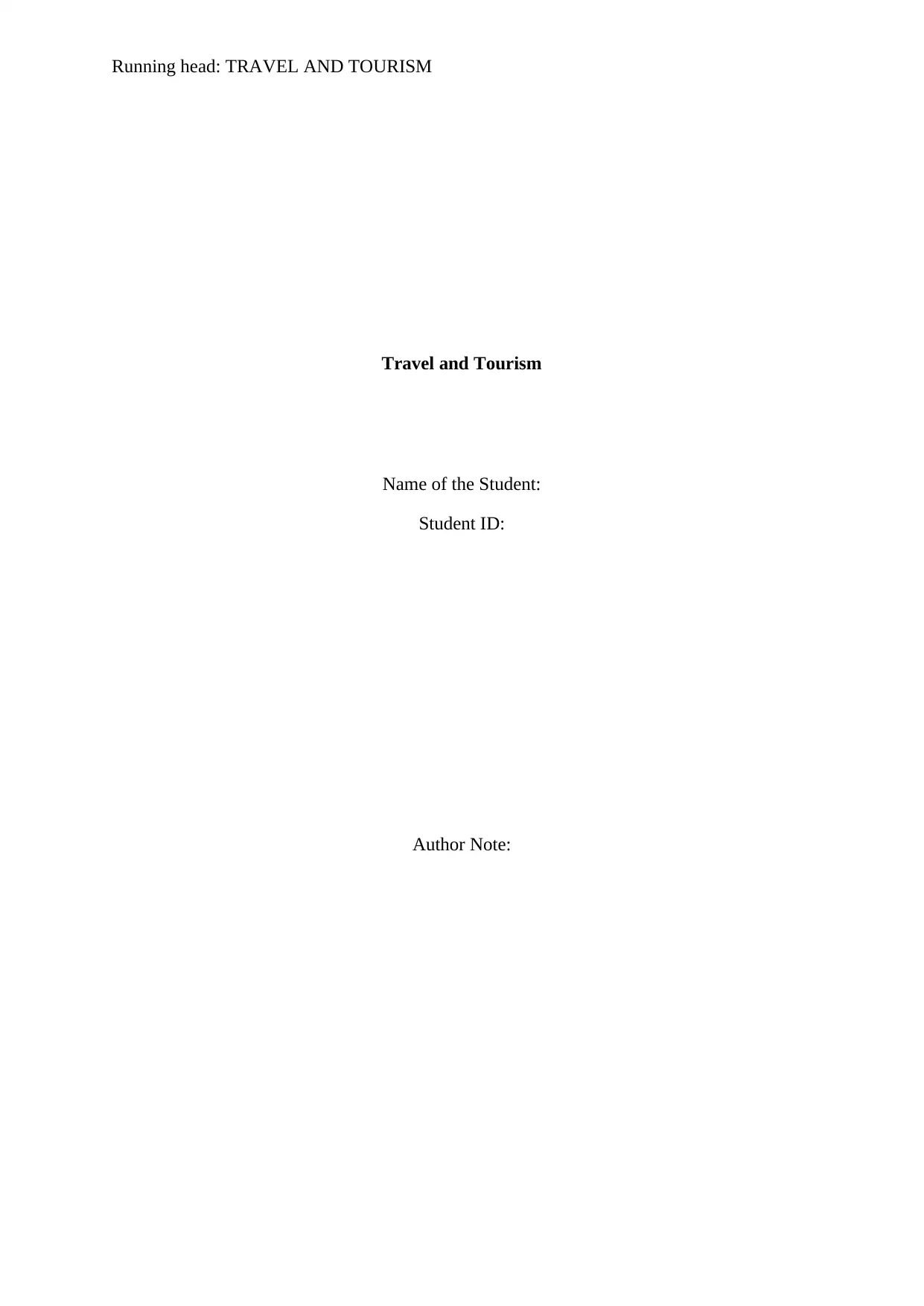
Running head: TRAVEL AND TOURISM
Travel and Tourism
Name of the Student:
Student ID:
Author Note:
Travel and Tourism
Name of the Student:
Student ID:
Author Note:
Secure Best Marks with AI Grader
Need help grading? Try our AI Grader for instant feedback on your assignments.
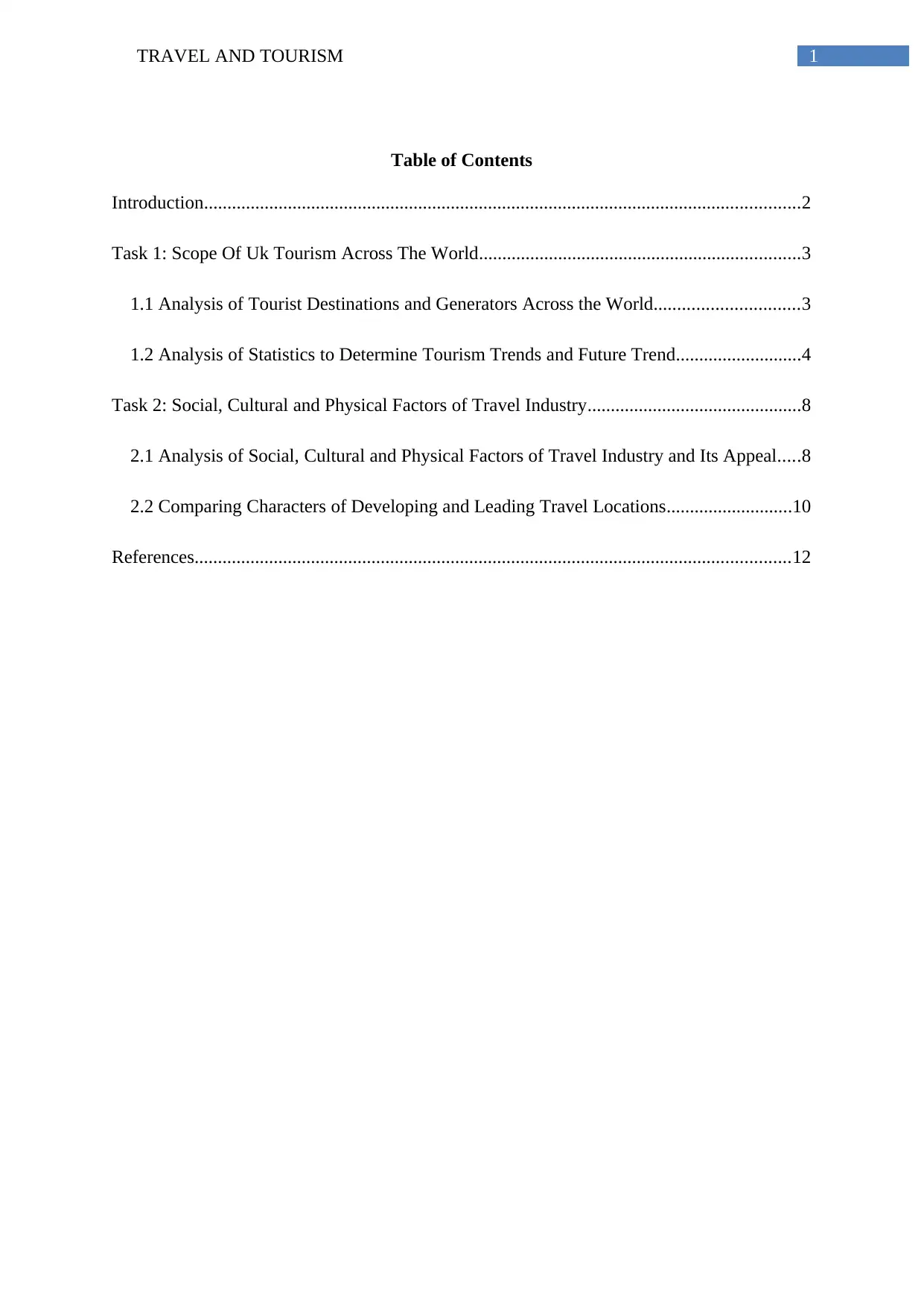
1TRAVEL AND TOURISM
Table of Contents
Introduction................................................................................................................................2
Task 1: Scope Of Uk Tourism Across The World.....................................................................3
1.1 Analysis of Tourist Destinations and Generators Across the World...............................3
1.2 Analysis of Statistics to Determine Tourism Trends and Future Trend...........................4
Task 2: Social, Cultural and Physical Factors of Travel Industry..............................................8
2.1 Analysis of Social, Cultural and Physical Factors of Travel Industry and Its Appeal.....8
2.2 Comparing Characters of Developing and Leading Travel Locations...........................10
References................................................................................................................................12
Table of Contents
Introduction................................................................................................................................2
Task 1: Scope Of Uk Tourism Across The World.....................................................................3
1.1 Analysis of Tourist Destinations and Generators Across the World...............................3
1.2 Analysis of Statistics to Determine Tourism Trends and Future Trend...........................4
Task 2: Social, Cultural and Physical Factors of Travel Industry..............................................8
2.1 Analysis of Social, Cultural and Physical Factors of Travel Industry and Its Appeal.....8
2.2 Comparing Characters of Developing and Leading Travel Locations...........................10
References................................................................................................................................12
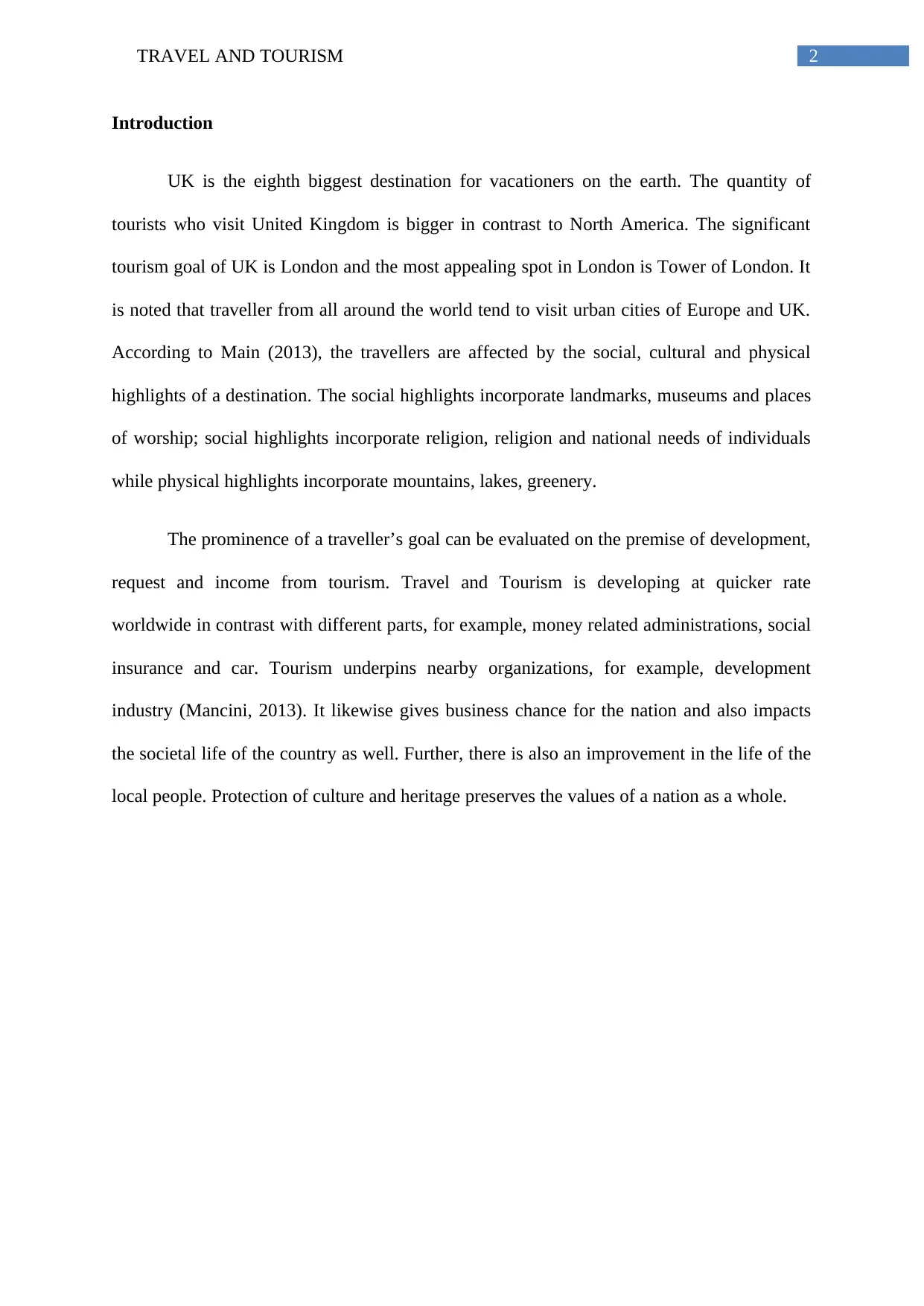
2TRAVEL AND TOURISM
Introduction
UK is the eighth biggest destination for vacationers on the earth. The quantity of
tourists who visit United Kingdom is bigger in contrast to North America. The significant
tourism goal of UK is London and the most appealing spot in London is Tower of London. It
is noted that traveller from all around the world tend to visit urban cities of Europe and UK.
According to Main (2013), the travellers are affected by the social, cultural and physical
highlights of a destination. The social highlights incorporate landmarks, museums and places
of worship; social highlights incorporate religion, religion and national needs of individuals
while physical highlights incorporate mountains, lakes, greenery.
The prominence of a traveller’s goal can be evaluated on the premise of development,
request and income from tourism. Travel and Tourism is developing at quicker rate
worldwide in contrast with different parts, for example, money related administrations, social
insurance and car. Tourism underpins nearby organizations, for example, development
industry (Mancini, 2013). It likewise gives business chance for the nation and also impacts
the societal life of the country as well. Further, there is also an improvement in the life of the
local people. Protection of culture and heritage preserves the values of a nation as a whole.
Introduction
UK is the eighth biggest destination for vacationers on the earth. The quantity of
tourists who visit United Kingdom is bigger in contrast to North America. The significant
tourism goal of UK is London and the most appealing spot in London is Tower of London. It
is noted that traveller from all around the world tend to visit urban cities of Europe and UK.
According to Main (2013), the travellers are affected by the social, cultural and physical
highlights of a destination. The social highlights incorporate landmarks, museums and places
of worship; social highlights incorporate religion, religion and national needs of individuals
while physical highlights incorporate mountains, lakes, greenery.
The prominence of a traveller’s goal can be evaluated on the premise of development,
request and income from tourism. Travel and Tourism is developing at quicker rate
worldwide in contrast with different parts, for example, money related administrations, social
insurance and car. Tourism underpins nearby organizations, for example, development
industry (Mancini, 2013). It likewise gives business chance for the nation and also impacts
the societal life of the country as well. Further, there is also an improvement in the life of the
local people. Protection of culture and heritage preserves the values of a nation as a whole.
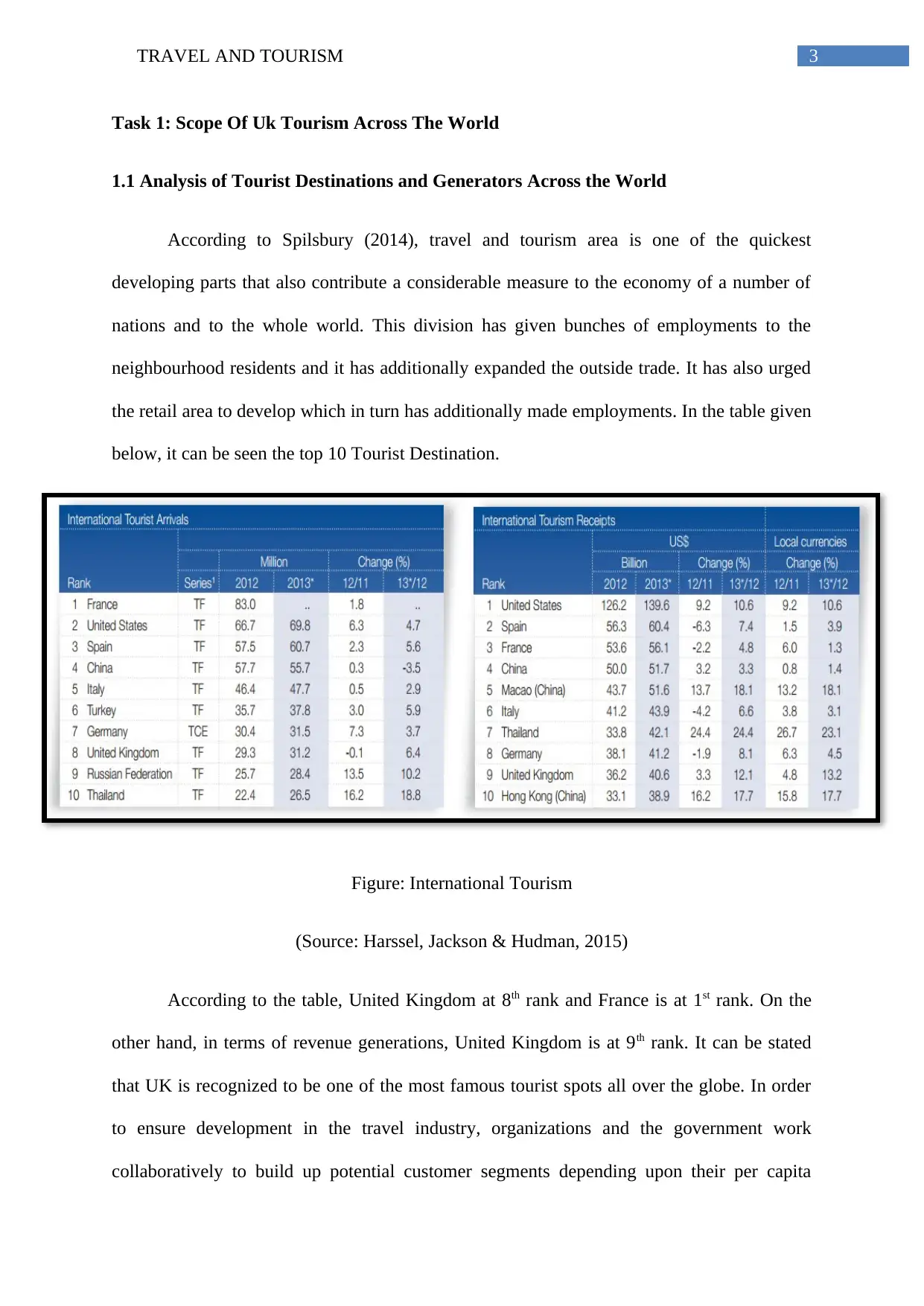
3TRAVEL AND TOURISM
Task 1: Scope Of Uk Tourism Across The World
1.1 Analysis of Tourist Destinations and Generators Across the World
According to Spilsbury (2014), travel and tourism area is one of the quickest
developing parts that also contribute a considerable measure to the economy of a number of
nations and to the whole world. This division has given bunches of employments to the
neighbourhood residents and it has additionally expanded the outside trade. It has also urged
the retail area to develop which in turn has additionally made employments. In the table given
below, it can be seen the top 10 Tourist Destination.
Figure: International Tourism
(Source: Harssel, Jackson & Hudman, 2015)
According to the table, United Kingdom at 8th rank and France is at 1st rank. On the
other hand, in terms of revenue generations, United Kingdom is at 9th rank. It can be stated
that UK is recognized to be one of the most famous tourist spots all over the globe. In order
to ensure development in the travel industry, organizations and the government work
collaboratively to build up potential customer segments depending upon their per capita
Task 1: Scope Of Uk Tourism Across The World
1.1 Analysis of Tourist Destinations and Generators Across the World
According to Spilsbury (2014), travel and tourism area is one of the quickest
developing parts that also contribute a considerable measure to the economy of a number of
nations and to the whole world. This division has given bunches of employments to the
neighbourhood residents and it has additionally expanded the outside trade. It has also urged
the retail area to develop which in turn has additionally made employments. In the table given
below, it can be seen the top 10 Tourist Destination.
Figure: International Tourism
(Source: Harssel, Jackson & Hudman, 2015)
According to the table, United Kingdom at 8th rank and France is at 1st rank. On the
other hand, in terms of revenue generations, United Kingdom is at 9th rank. It can be stated
that UK is recognized to be one of the most famous tourist spots all over the globe. In order
to ensure development in the travel industry, organizations and the government work
collaboratively to build up potential customer segments depending upon their per capita
Secure Best Marks with AI Grader
Need help grading? Try our AI Grader for instant feedback on your assignments.

4TRAVEL AND TOURISM
income or on their individual perspectives (Becker, 2016). Being divided into four separate
divisions, Wales, Scotland, Britain and Ireland, the country provides diversified services to
the visitors. Additionally, man-made spots and natural spots help to develop business
conditions for the performing firms in the sector. Several locations like waterfalls, national
parks and mountains have received a lot of attention in the past few years. On the other hand,
historic centres, sanctuaries, different religious spots, working locales, exhibitions and many
other areas have also helped in this regards. Some the most famous attractions in the United
Kingdom are: London Eye, Tate and Tate, The Victoria and Albert Museum, Tower of
London and National British Museum. Among the many others, Thorpe Park is outstanding
amongst other amusement stops in the nation. As per Barker (2015), a few other famous
attractions of the United Kingdom are Eden Project, Kew Gardens, Legoland Windsor,
Windermere Lake, Flamingo Areas, Canterbury Cathedral, New MetroLand and Chester Zoo.
1.2 Analysis of Statistics to Determine Tourism Trends and Future Trend
Based on the below chart, it can be inferred that there will be analysis of the patterns
in the business with the assistance of a few cases. In the report, we will initially take the
inbound voyagers in the nation and will set up a chart demonstrating the quantity of guests in
the nation in the last few months. The chart will likewise demonstrate the motivation behind
visit, for example, business trips, occasion with family or companions, VFR, or some other
reason and so forth. England will be viewed as first and will be examined.
income or on their individual perspectives (Becker, 2016). Being divided into four separate
divisions, Wales, Scotland, Britain and Ireland, the country provides diversified services to
the visitors. Additionally, man-made spots and natural spots help to develop business
conditions for the performing firms in the sector. Several locations like waterfalls, national
parks and mountains have received a lot of attention in the past few years. On the other hand,
historic centres, sanctuaries, different religious spots, working locales, exhibitions and many
other areas have also helped in this regards. Some the most famous attractions in the United
Kingdom are: London Eye, Tate and Tate, The Victoria and Albert Museum, Tower of
London and National British Museum. Among the many others, Thorpe Park is outstanding
amongst other amusement stops in the nation. As per Barker (2015), a few other famous
attractions of the United Kingdom are Eden Project, Kew Gardens, Legoland Windsor,
Windermere Lake, Flamingo Areas, Canterbury Cathedral, New MetroLand and Chester Zoo.
1.2 Analysis of Statistics to Determine Tourism Trends and Future Trend
Based on the below chart, it can be inferred that there will be analysis of the patterns
in the business with the assistance of a few cases. In the report, we will initially take the
inbound voyagers in the nation and will set up a chart demonstrating the quantity of guests in
the nation in the last few months. The chart will likewise demonstrate the motivation behind
visit, for example, business trips, occasion with family or companions, VFR, or some other
reason and so forth. England will be viewed as first and will be examined.
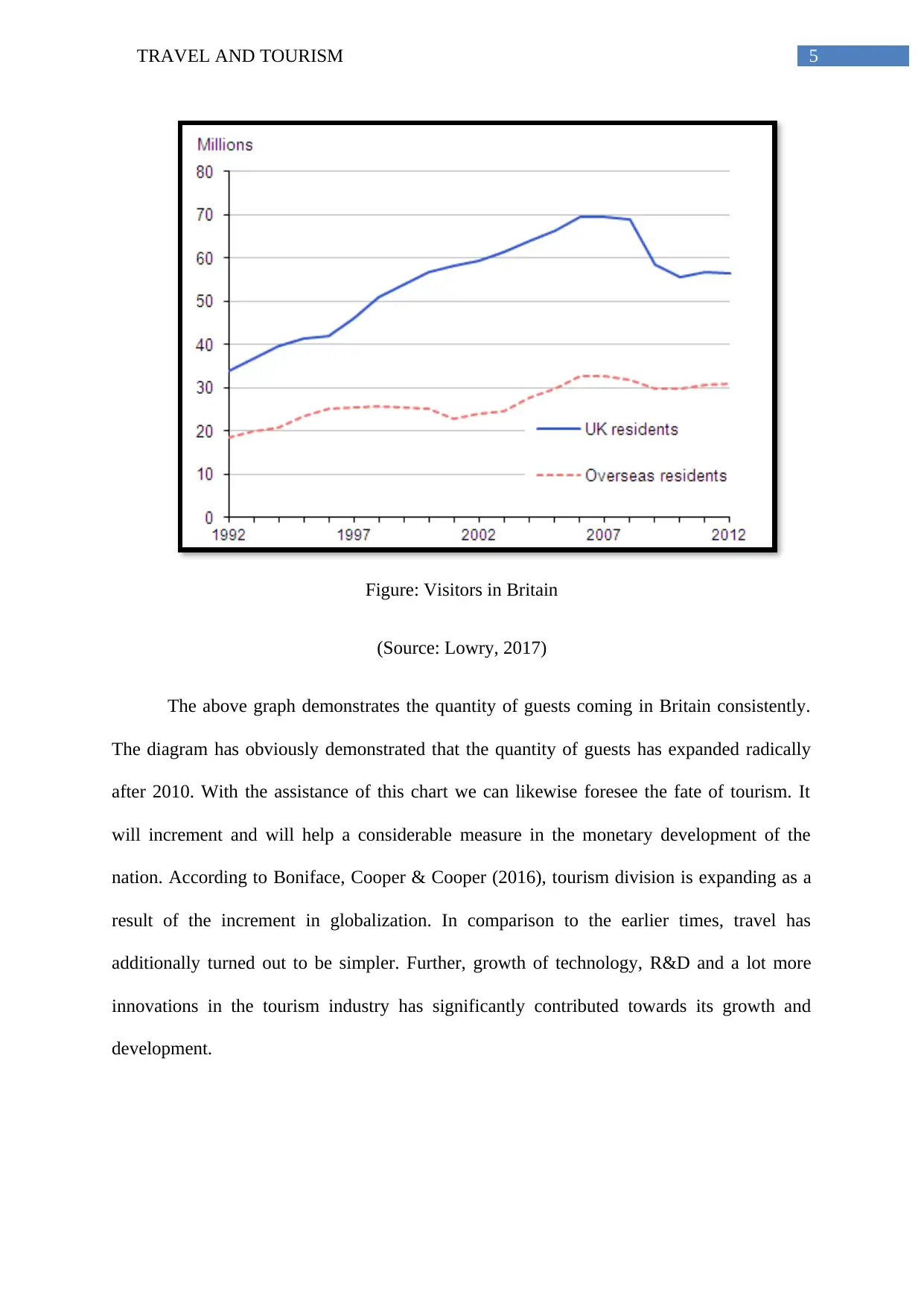
5TRAVEL AND TOURISM
Figure: Visitors in Britain
(Source: Lowry, 2017)
The above graph demonstrates the quantity of guests coming in Britain consistently.
The diagram has obviously demonstrated that the quantity of guests has expanded radically
after 2010. With the assistance of this chart we can likewise foresee the fate of tourism. It
will increment and will help a considerable measure in the monetary development of the
nation. According to Boniface, Cooper & Cooper (2016), tourism division is expanding as a
result of the increment in globalization. In comparison to the earlier times, travel has
additionally turned out to be simpler. Further, growth of technology, R&D and a lot more
innovations in the tourism industry has significantly contributed towards its growth and
development.
Figure: Visitors in Britain
(Source: Lowry, 2017)
The above graph demonstrates the quantity of guests coming in Britain consistently.
The diagram has obviously demonstrated that the quantity of guests has expanded radically
after 2010. With the assistance of this chart we can likewise foresee the fate of tourism. It
will increment and will help a considerable measure in the monetary development of the
nation. According to Boniface, Cooper & Cooper (2016), tourism division is expanding as a
result of the increment in globalization. In comparison to the earlier times, travel has
additionally turned out to be simpler. Further, growth of technology, R&D and a lot more
innovations in the tourism industry has significantly contributed towards its growth and
development.
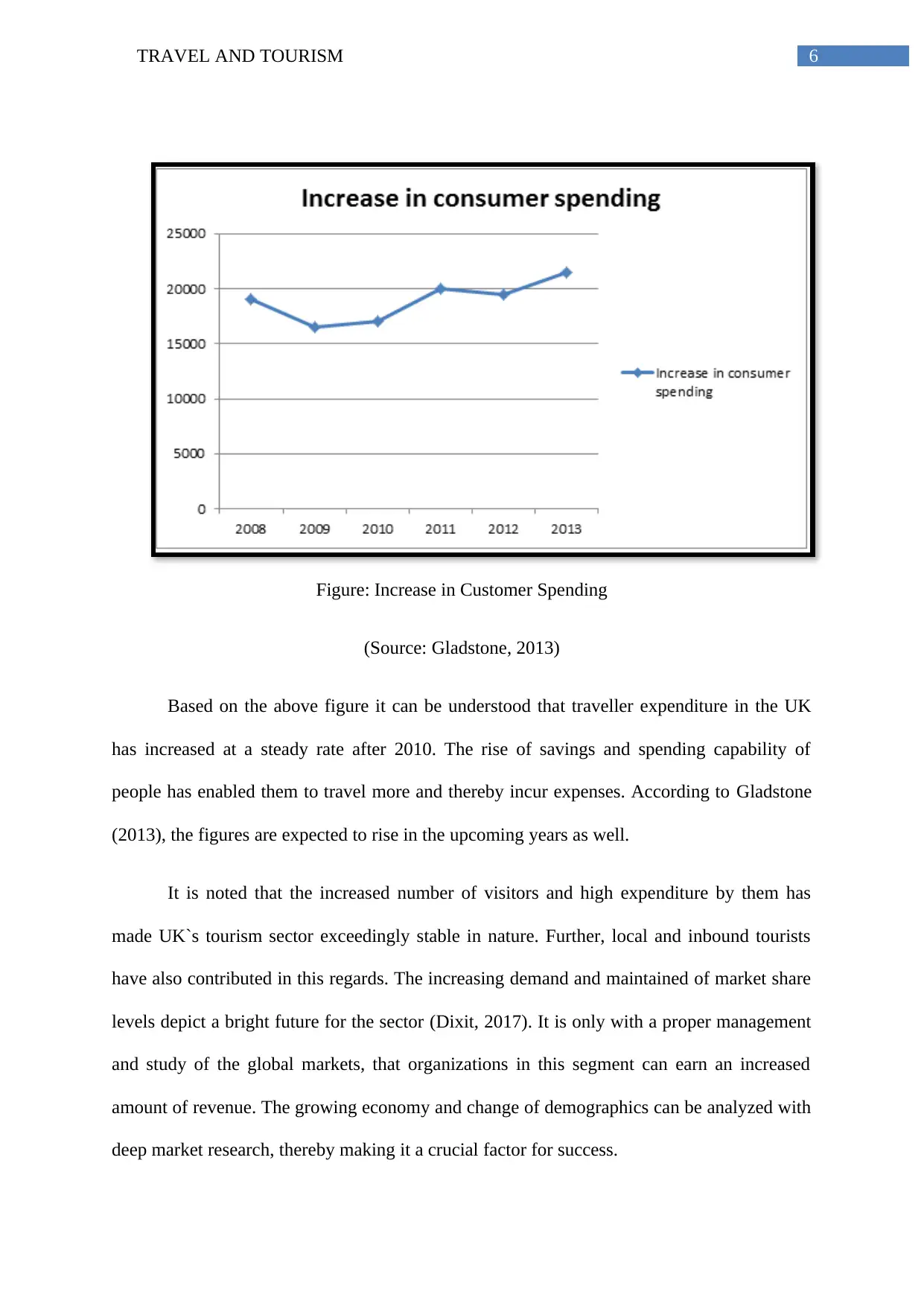
6TRAVEL AND TOURISM
Figure: Increase in Customer Spending
(Source: Gladstone, 2013)
Based on the above figure it can be understood that traveller expenditure in the UK
has increased at a steady rate after 2010. The rise of savings and spending capability of
people has enabled them to travel more and thereby incur expenses. According to Gladstone
(2013), the figures are expected to rise in the upcoming years as well.
It is noted that the increased number of visitors and high expenditure by them has
made UK`s tourism sector exceedingly stable in nature. Further, local and inbound tourists
have also contributed in this regards. The increasing demand and maintained of market share
levels depict a bright future for the sector (Dixit, 2017). It is only with a proper management
and study of the global markets, that organizations in this segment can earn an increased
amount of revenue. The growing economy and change of demographics can be analyzed with
deep market research, thereby making it a crucial factor for success.
Figure: Increase in Customer Spending
(Source: Gladstone, 2013)
Based on the above figure it can be understood that traveller expenditure in the UK
has increased at a steady rate after 2010. The rise of savings and spending capability of
people has enabled them to travel more and thereby incur expenses. According to Gladstone
(2013), the figures are expected to rise in the upcoming years as well.
It is noted that the increased number of visitors and high expenditure by them has
made UK`s tourism sector exceedingly stable in nature. Further, local and inbound tourists
have also contributed in this regards. The increasing demand and maintained of market share
levels depict a bright future for the sector (Dixit, 2017). It is only with a proper management
and study of the global markets, that organizations in this segment can earn an increased
amount of revenue. The growing economy and change of demographics can be analyzed with
deep market research, thereby making it a crucial factor for success.
Paraphrase This Document
Need a fresh take? Get an instant paraphrase of this document with our AI Paraphraser
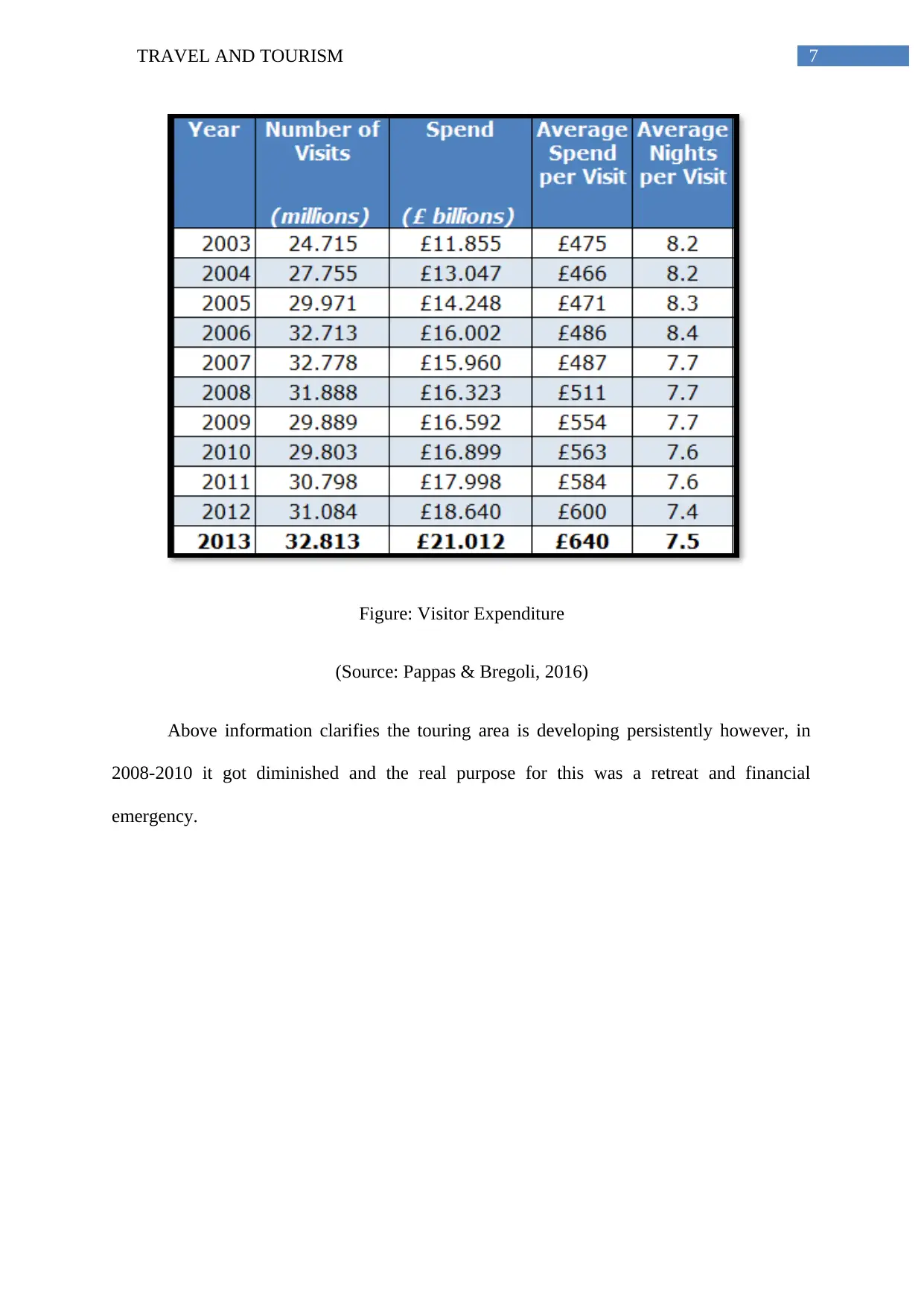
7TRAVEL AND TOURISM
Figure: Visitor Expenditure
(Source: Pappas & Bregoli, 2016)
Above information clarifies the touring area is developing persistently however, in
2008-2010 it got diminished and the real purpose for this was a retreat and financial
emergency.
Figure: Visitor Expenditure
(Source: Pappas & Bregoli, 2016)
Above information clarifies the touring area is developing persistently however, in
2008-2010 it got diminished and the real purpose for this was a retreat and financial
emergency.
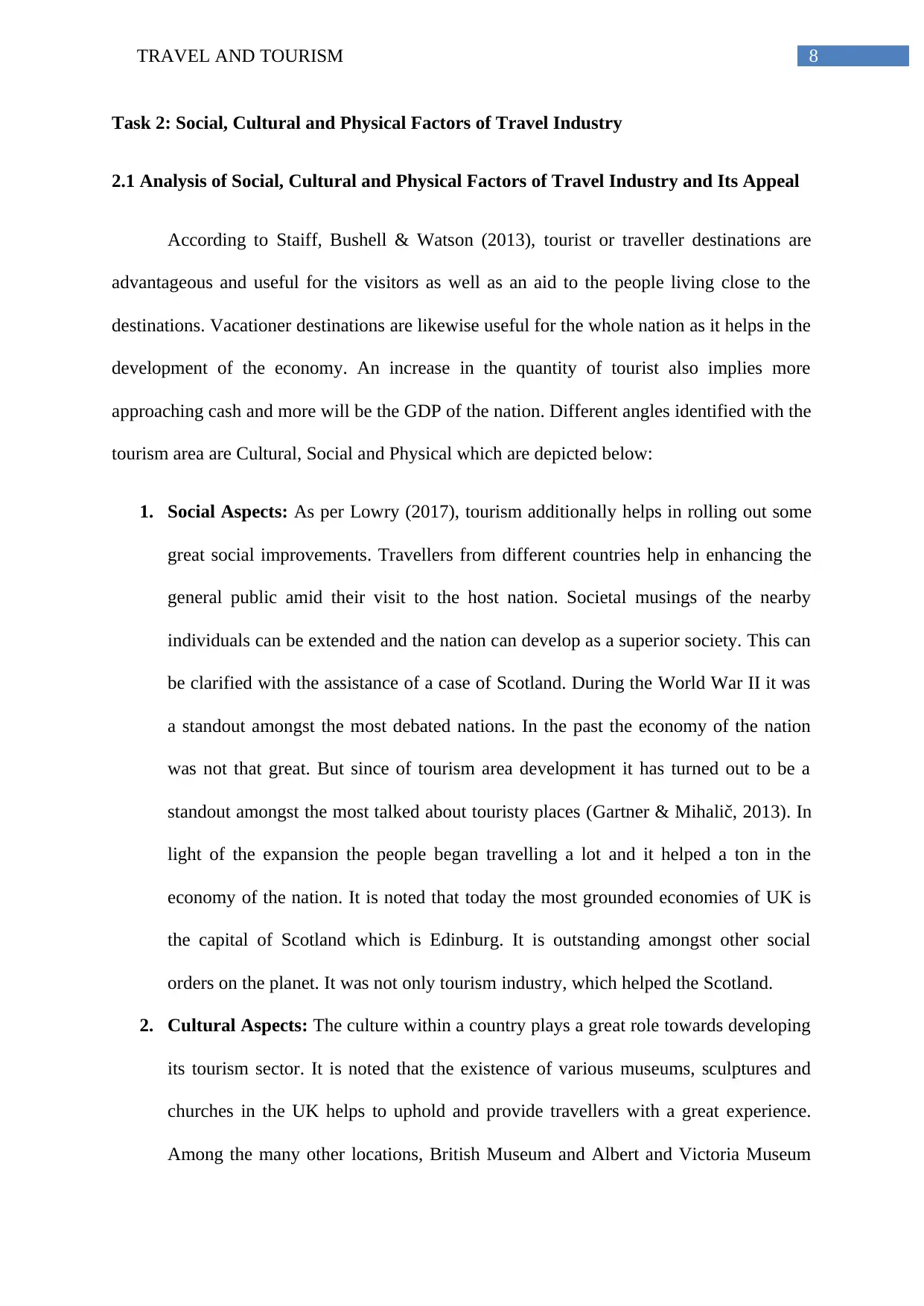
8TRAVEL AND TOURISM
Task 2: Social, Cultural and Physical Factors of Travel Industry
2.1 Analysis of Social, Cultural and Physical Factors of Travel Industry and Its Appeal
According to Staiff, Bushell & Watson (2013), tourist or traveller destinations are
advantageous and useful for the visitors as well as an aid to the people living close to the
destinations. Vacationer destinations are likewise useful for the whole nation as it helps in the
development of the economy. An increase in the quantity of tourist also implies more
approaching cash and more will be the GDP of the nation. Different angles identified with the
tourism area are Cultural, Social and Physical which are depicted below:
1. Social Aspects: As per Lowry (2017), tourism additionally helps in rolling out some
great social improvements. Travellers from different countries help in enhancing the
general public amid their visit to the host nation. Societal musings of the nearby
individuals can be extended and the nation can develop as a superior society. This can
be clarified with the assistance of a case of Scotland. During the World War II it was
a standout amongst the most debated nations. In the past the economy of the nation
was not that great. But since of tourism area development it has turned out to be a
standout amongst the most talked about touristy places (Gartner & Mihalič, 2013) . In
light of the expansion the people began travelling a lot and it helped a ton in the
economy of the nation. It is noted that today the most grounded economies of UK is
the capital of Scotland which is Edinburg. It is outstanding amongst other social
orders on the planet. It was not only tourism industry, which helped the Scotland.
2. Cultural Aspects: The culture within a country plays a great role towards developing
its tourism sector. It is noted that the existence of various museums, sculptures and
churches in the UK helps to uphold and provide travellers with a great experience.
Among the many other locations, British Museum and Albert and Victoria Museum
Task 2: Social, Cultural and Physical Factors of Travel Industry
2.1 Analysis of Social, Cultural and Physical Factors of Travel Industry and Its Appeal
According to Staiff, Bushell & Watson (2013), tourist or traveller destinations are
advantageous and useful for the visitors as well as an aid to the people living close to the
destinations. Vacationer destinations are likewise useful for the whole nation as it helps in the
development of the economy. An increase in the quantity of tourist also implies more
approaching cash and more will be the GDP of the nation. Different angles identified with the
tourism area are Cultural, Social and Physical which are depicted below:
1. Social Aspects: As per Lowry (2017), tourism additionally helps in rolling out some
great social improvements. Travellers from different countries help in enhancing the
general public amid their visit to the host nation. Societal musings of the nearby
individuals can be extended and the nation can develop as a superior society. This can
be clarified with the assistance of a case of Scotland. During the World War II it was
a standout amongst the most debated nations. In the past the economy of the nation
was not that great. But since of tourism area development it has turned out to be a
standout amongst the most talked about touristy places (Gartner & Mihalič, 2013) . In
light of the expansion the people began travelling a lot and it helped a ton in the
economy of the nation. It is noted that today the most grounded economies of UK is
the capital of Scotland which is Edinburg. It is outstanding amongst other social
orders on the planet. It was not only tourism industry, which helped the Scotland.
2. Cultural Aspects: The culture within a country plays a great role towards developing
its tourism sector. It is noted that the existence of various museums, sculptures and
churches in the UK helps to uphold and provide travellers with a great experience.
Among the many other locations, British Museum and Albert and Victoria Museum
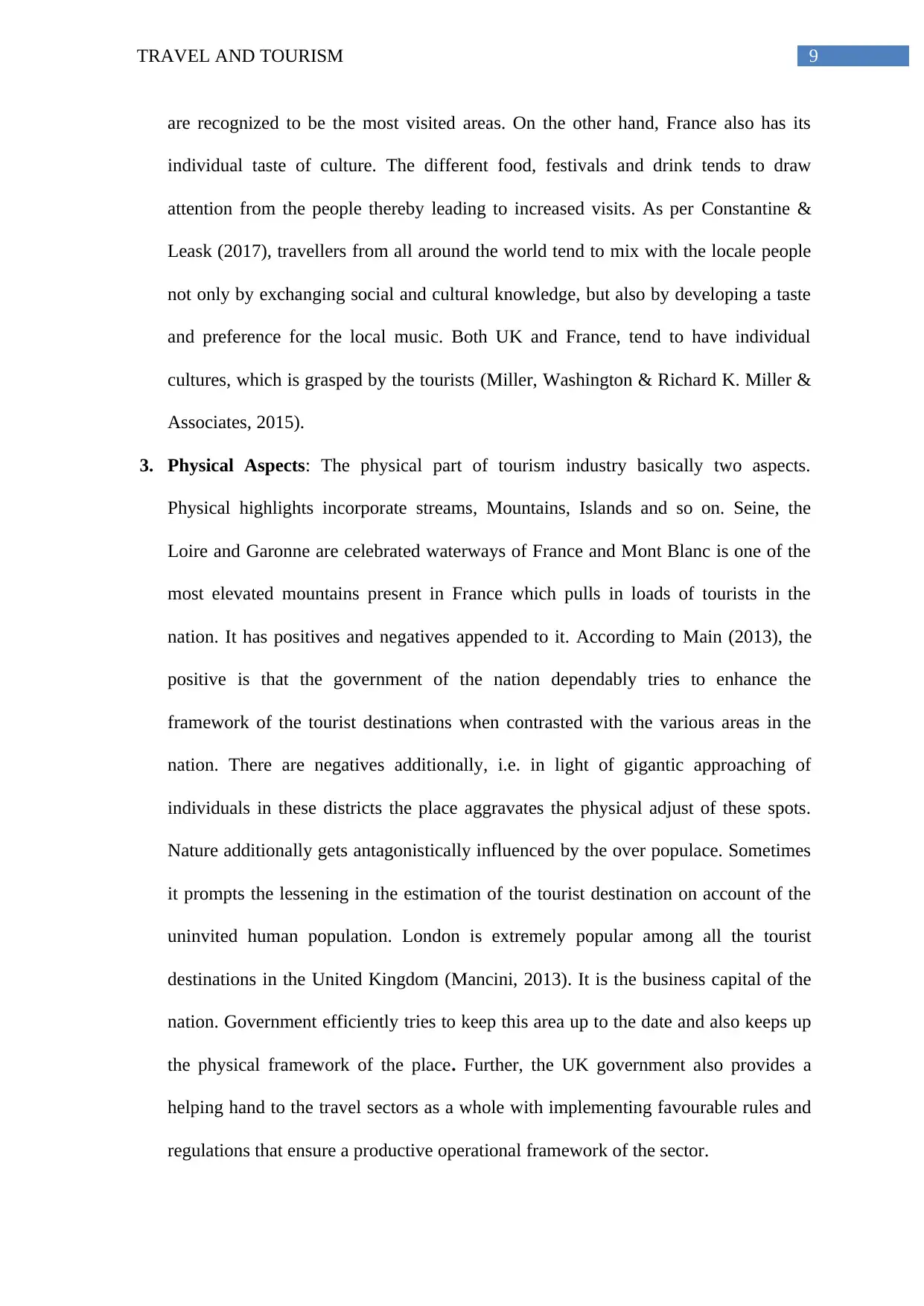
9TRAVEL AND TOURISM
are recognized to be the most visited areas. On the other hand, France also has its
individual taste of culture. The different food, festivals and drink tends to draw
attention from the people thereby leading to increased visits. As per Constantine &
Leask (2017), travellers from all around the world tend to mix with the locale people
not only by exchanging social and cultural knowledge, but also by developing a taste
and preference for the local music. Both UK and France, tend to have individual
cultures, which is grasped by the tourists (Miller, Washington & Richard K. Miller &
Associates, 2015).
3. Physical Aspects: The physical part of tourism industry basically two aspects.
Physical highlights incorporate streams, Mountains, Islands and so on. Seine, the
Loire and Garonne are celebrated waterways of France and Mont Blanc is one of the
most elevated mountains present in France which pulls in loads of tourists in the
nation. It has positives and negatives appended to it. According to Main (2013), the
positive is that the government of the nation dependably tries to enhance the
framework of the tourist destinations when contrasted with the various areas in the
nation. There are negatives additionally, i.e. in light of gigantic approaching of
individuals in these districts the place aggravates the physical adjust of these spots.
Nature additionally gets antagonistically influenced by the over populace. Sometimes
it prompts the lessening in the estimation of the tourist destination on account of the
uninvited human population. London is extremely popular among all the tourist
destinations in the United Kingdom (Mancini, 2013). It is the business capital of the
nation. Government efficiently tries to keep this area up to the date and also keeps up
the physical framework of the place. Further, the UK government also provides a
helping hand to the travel sectors as a whole with implementing favourable rules and
regulations that ensure a productive operational framework of the sector.
are recognized to be the most visited areas. On the other hand, France also has its
individual taste of culture. The different food, festivals and drink tends to draw
attention from the people thereby leading to increased visits. As per Constantine &
Leask (2017), travellers from all around the world tend to mix with the locale people
not only by exchanging social and cultural knowledge, but also by developing a taste
and preference for the local music. Both UK and France, tend to have individual
cultures, which is grasped by the tourists (Miller, Washington & Richard K. Miller &
Associates, 2015).
3. Physical Aspects: The physical part of tourism industry basically two aspects.
Physical highlights incorporate streams, Mountains, Islands and so on. Seine, the
Loire and Garonne are celebrated waterways of France and Mont Blanc is one of the
most elevated mountains present in France which pulls in loads of tourists in the
nation. It has positives and negatives appended to it. According to Main (2013), the
positive is that the government of the nation dependably tries to enhance the
framework of the tourist destinations when contrasted with the various areas in the
nation. There are negatives additionally, i.e. in light of gigantic approaching of
individuals in these districts the place aggravates the physical adjust of these spots.
Nature additionally gets antagonistically influenced by the over populace. Sometimes
it prompts the lessening in the estimation of the tourist destination on account of the
uninvited human population. London is extremely popular among all the tourist
destinations in the United Kingdom (Mancini, 2013). It is the business capital of the
nation. Government efficiently tries to keep this area up to the date and also keeps up
the physical framework of the place. Further, the UK government also provides a
helping hand to the travel sectors as a whole with implementing favourable rules and
regulations that ensure a productive operational framework of the sector.
Secure Best Marks with AI Grader
Need help grading? Try our AI Grader for instant feedback on your assignments.
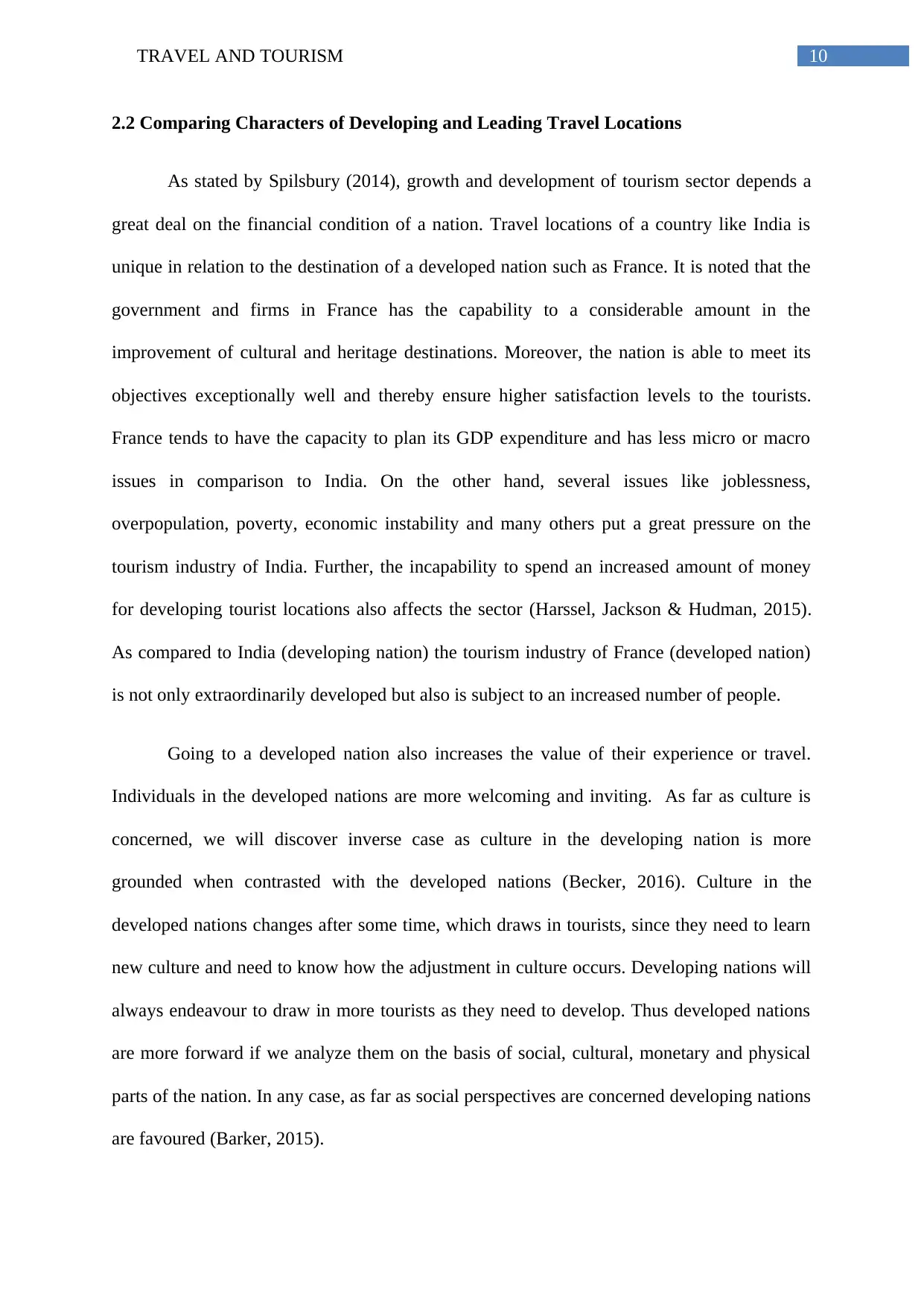
10TRAVEL AND TOURISM
2.2 Comparing Characters of Developing and Leading Travel Locations
As stated by Spilsbury (2014), growth and development of tourism sector depends a
great deal on the financial condition of a nation. Travel locations of a country like India is
unique in relation to the destination of a developed nation such as France. It is noted that the
government and firms in France has the capability to a considerable amount in the
improvement of cultural and heritage destinations. Moreover, the nation is able to meet its
objectives exceptionally well and thereby ensure higher satisfaction levels to the tourists.
France tends to have the capacity to plan its GDP expenditure and has less micro or macro
issues in comparison to India. On the other hand, several issues like joblessness,
overpopulation, poverty, economic instability and many others put a great pressure on the
tourism industry of India. Further, the incapability to spend an increased amount of money
for developing tourist locations also affects the sector (Harssel, Jackson & Hudman, 2015).
As compared to India (developing nation) the tourism industry of France (developed nation)
is not only extraordinarily developed but also is subject to an increased number of people.
Going to a developed nation also increases the value of their experience or travel.
Individuals in the developed nations are more welcoming and inviting. As far as culture is
concerned, we will discover inverse case as culture in the developing nation is more
grounded when contrasted with the developed nations (Becker, 2016). Culture in the
developed nations changes after some time, which draws in tourists, since they need to learn
new culture and need to know how the adjustment in culture occurs. Developing nations will
always endeavour to draw in more tourists as they need to develop. Thus developed nations
are more forward if we analyze them on the basis of social, cultural, monetary and physical
parts of the nation. In any case, as far as social perspectives are concerned developing nations
are favoured (Barker, 2015).
2.2 Comparing Characters of Developing and Leading Travel Locations
As stated by Spilsbury (2014), growth and development of tourism sector depends a
great deal on the financial condition of a nation. Travel locations of a country like India is
unique in relation to the destination of a developed nation such as France. It is noted that the
government and firms in France has the capability to a considerable amount in the
improvement of cultural and heritage destinations. Moreover, the nation is able to meet its
objectives exceptionally well and thereby ensure higher satisfaction levels to the tourists.
France tends to have the capacity to plan its GDP expenditure and has less micro or macro
issues in comparison to India. On the other hand, several issues like joblessness,
overpopulation, poverty, economic instability and many others put a great pressure on the
tourism industry of India. Further, the incapability to spend an increased amount of money
for developing tourist locations also affects the sector (Harssel, Jackson & Hudman, 2015).
As compared to India (developing nation) the tourism industry of France (developed nation)
is not only extraordinarily developed but also is subject to an increased number of people.
Going to a developed nation also increases the value of their experience or travel.
Individuals in the developed nations are more welcoming and inviting. As far as culture is
concerned, we will discover inverse case as culture in the developing nation is more
grounded when contrasted with the developed nations (Becker, 2016). Culture in the
developed nations changes after some time, which draws in tourists, since they need to learn
new culture and need to know how the adjustment in culture occurs. Developing nations will
always endeavour to draw in more tourists as they need to develop. Thus developed nations
are more forward if we analyze them on the basis of social, cultural, monetary and physical
parts of the nation. In any case, as far as social perspectives are concerned developing nations
are favoured (Barker, 2015).
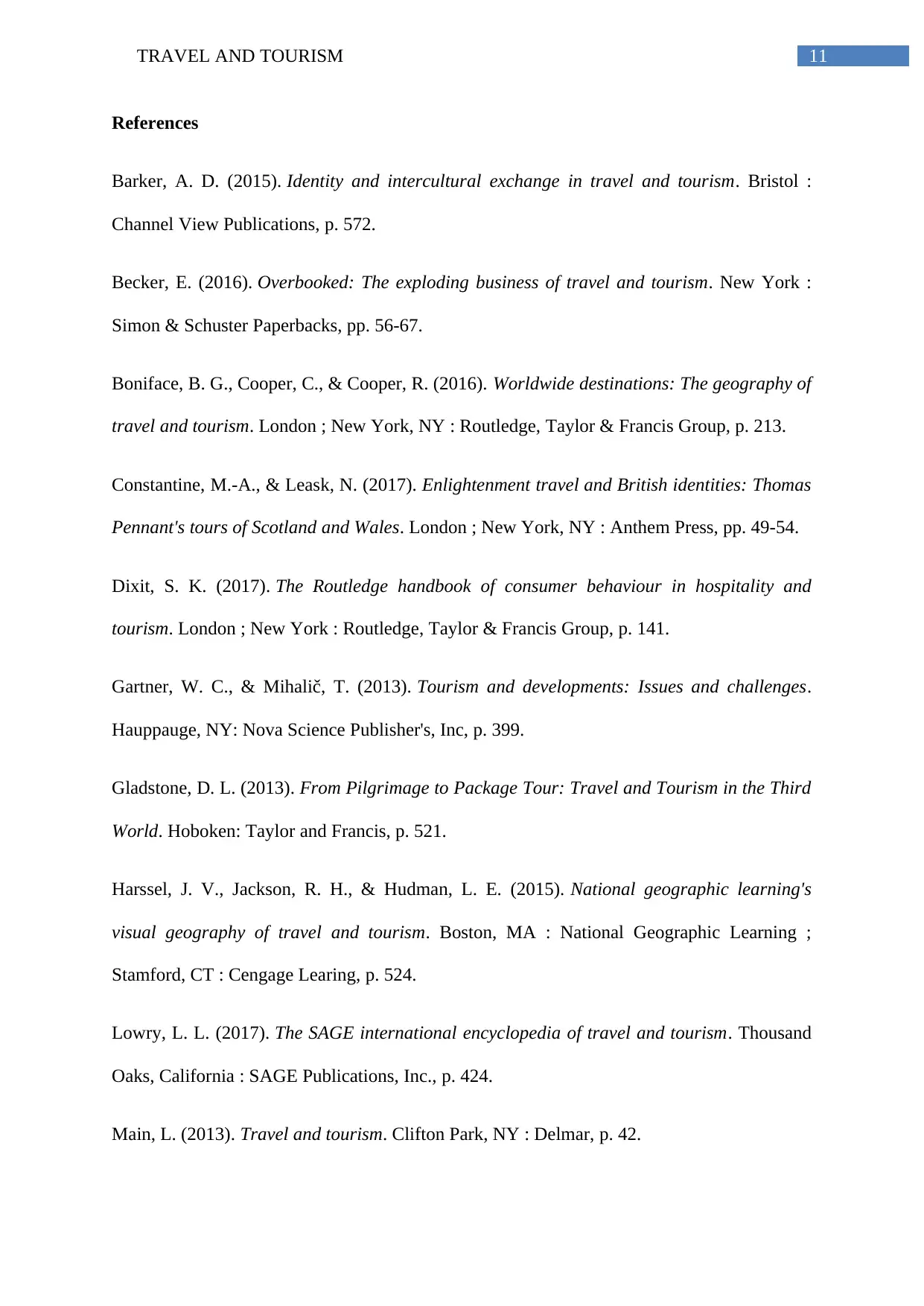
11TRAVEL AND TOURISM
References
Barker, A. D. (2015). Identity and intercultural exchange in travel and tourism. Bristol :
Channel View Publications, p. 572.
Becker, E. (2016). Overbooked: The exploding business of travel and tourism. New York :
Simon & Schuster Paperbacks, pp. 56-67.
Boniface, B. G., Cooper, C., & Cooper, R. (2016). Worldwide destinations: The geography of
travel and tourism. London ; New York, NY : Routledge, Taylor & Francis Group, p. 213.
Constantine, M.-A., & Leask, N. (2017). Enlightenment travel and British identities: Thomas
Pennant's tours of Scotland and Wales. London ; New York, NY : Anthem Press, pp. 49-54.
Dixit, S. K. (2017). The Routledge handbook of consumer behaviour in hospitality and
tourism. London ; New York : Routledge, Taylor & Francis Group, p. 141.
Gartner, W. C., & Mihalič, T. (2013). Tourism and developments: Issues and challenges.
Hauppauge, NY: Nova Science Publisher's, Inc, p. 399.
Gladstone, D. L. (2013). From Pilgrimage to Package Tour: Travel and Tourism in the Third
World. Hoboken: Taylor and Francis, p. 521.
Harssel, J. V., Jackson, R. H., & Hudman, L. E. (2015). National geographic learning's
visual geography of travel and tourism. Boston, MA : National Geographic Learning ;
Stamford, CT : Cengage Learing, p. 524.
Lowry, L. L. (2017). The SAGE international encyclopedia of travel and tourism. Thousand
Oaks, California : SAGE Publications, Inc., p. 424.
Main, L. (2013). Travel and tourism. Clifton Park, NY : Delmar, p. 42.
References
Barker, A. D. (2015). Identity and intercultural exchange in travel and tourism. Bristol :
Channel View Publications, p. 572.
Becker, E. (2016). Overbooked: The exploding business of travel and tourism. New York :
Simon & Schuster Paperbacks, pp. 56-67.
Boniface, B. G., Cooper, C., & Cooper, R. (2016). Worldwide destinations: The geography of
travel and tourism. London ; New York, NY : Routledge, Taylor & Francis Group, p. 213.
Constantine, M.-A., & Leask, N. (2017). Enlightenment travel and British identities: Thomas
Pennant's tours of Scotland and Wales. London ; New York, NY : Anthem Press, pp. 49-54.
Dixit, S. K. (2017). The Routledge handbook of consumer behaviour in hospitality and
tourism. London ; New York : Routledge, Taylor & Francis Group, p. 141.
Gartner, W. C., & Mihalič, T. (2013). Tourism and developments: Issues and challenges.
Hauppauge, NY: Nova Science Publisher's, Inc, p. 399.
Gladstone, D. L. (2013). From Pilgrimage to Package Tour: Travel and Tourism in the Third
World. Hoboken: Taylor and Francis, p. 521.
Harssel, J. V., Jackson, R. H., & Hudman, L. E. (2015). National geographic learning's
visual geography of travel and tourism. Boston, MA : National Geographic Learning ;
Stamford, CT : Cengage Learing, p. 524.
Lowry, L. L. (2017). The SAGE international encyclopedia of travel and tourism. Thousand
Oaks, California : SAGE Publications, Inc., p. 424.
Main, L. (2013). Travel and tourism. Clifton Park, NY : Delmar, p. 42.
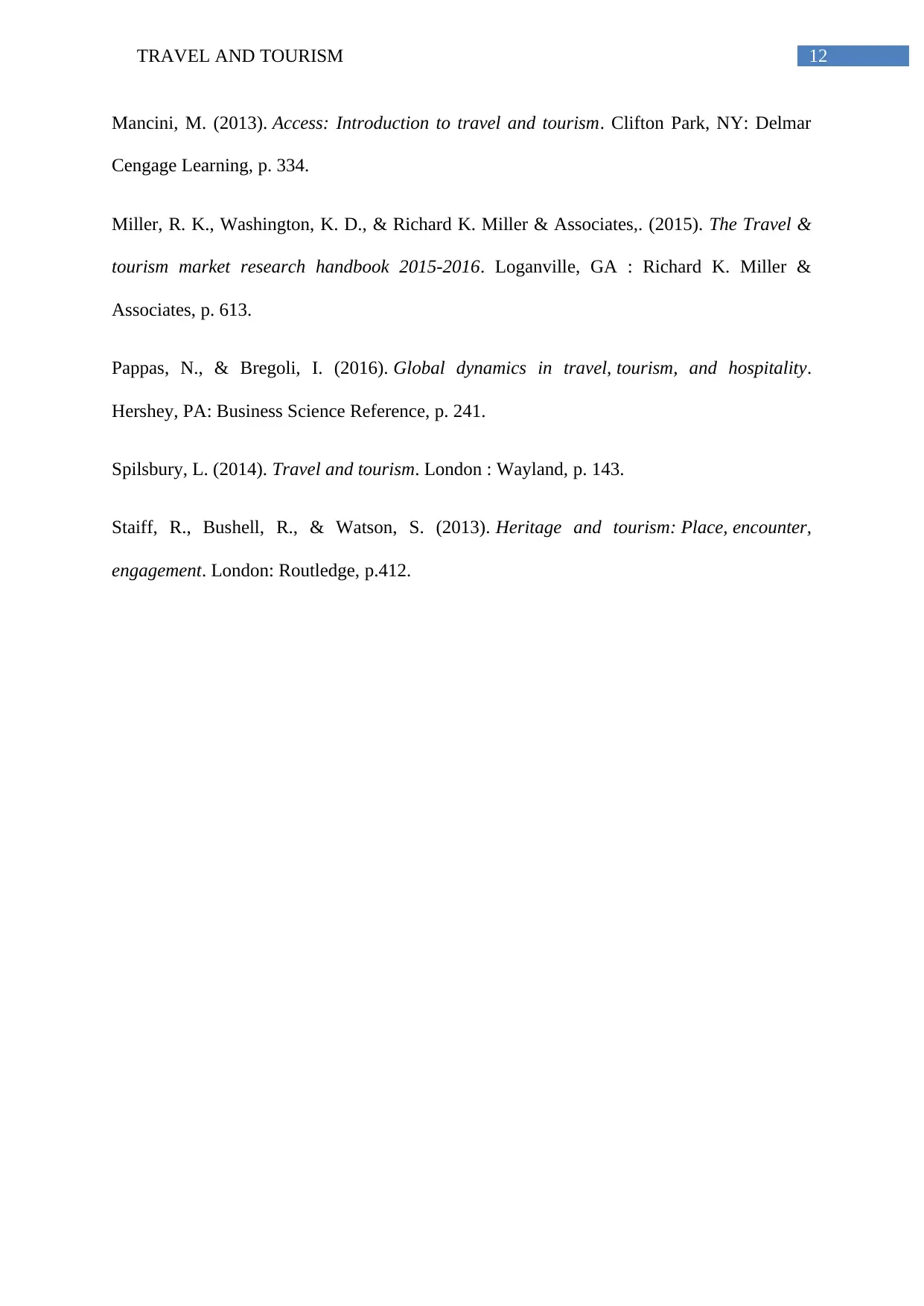
12TRAVEL AND TOURISM
Mancini, M. (2013). Access: Introduction to travel and tourism. Clifton Park, NY: Delmar
Cengage Learning, p. 334.
Miller, R. K., Washington, K. D., & Richard K. Miller & Associates,. (2015). The Travel &
tourism market research handbook 2015-2016. Loganville, GA : Richard K. Miller &
Associates, p. 613.
Pappas, N., & Bregoli, I. (2016). Global dynamics in travel, tourism, and hospitality.
Hershey, PA: Business Science Reference, p. 241.
Spilsbury, L. (2014). Travel and tourism. London : Wayland, p. 143.
Staiff, R., Bushell, R., & Watson, S. (2013). Heritage and tourism: Place, encounter,
engagement. London: Routledge, p.412.
Mancini, M. (2013). Access: Introduction to travel and tourism. Clifton Park, NY: Delmar
Cengage Learning, p. 334.
Miller, R. K., Washington, K. D., & Richard K. Miller & Associates,. (2015). The Travel &
tourism market research handbook 2015-2016. Loganville, GA : Richard K. Miller &
Associates, p. 613.
Pappas, N., & Bregoli, I. (2016). Global dynamics in travel, tourism, and hospitality.
Hershey, PA: Business Science Reference, p. 241.
Spilsbury, L. (2014). Travel and tourism. London : Wayland, p. 143.
Staiff, R., Bushell, R., & Watson, S. (2013). Heritage and tourism: Place, encounter,
engagement. London: Routledge, p.412.
1 out of 13
Related Documents
Your All-in-One AI-Powered Toolkit for Academic Success.
+13062052269
info@desklib.com
Available 24*7 on WhatsApp / Email
![[object Object]](/_next/static/media/star-bottom.7253800d.svg)
Unlock your academic potential
© 2024 | Zucol Services PVT LTD | All rights reserved.





